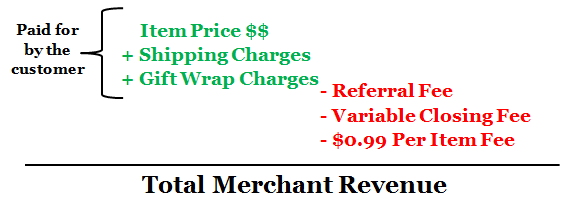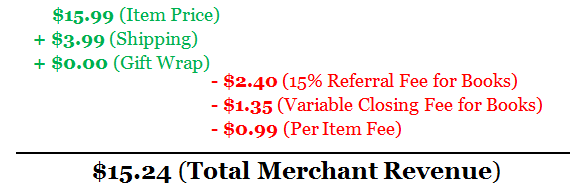Amazon
Amazon Selling Fees: How Much Will You Pay to Sell on The Amazon Marketplace?
The reality of online shopping is that most online purchase queries start on ecommerce marketplaces like Amazon.com. The Amazon Marketplace is known for its high traffic volume and conversion rate, making it a top marketing channel for online retailers.
If you’re interested in setting up an Amazon Marketplace campaign, you should know about the Amazon selling fees you’ll inevitably end up paying.
But first, here’s a quick recap on the how the Amazon Marketplace works:
- Transactions occur on Amazon.com, not your merchant website.
- Amazon selling fees are incurred on a cost per acquisition (CPA) model.
- A sold item’s revenue goes through the Amazon Marketplace and is then deposited to the merchant after the Amazon Marketplace selling fees are incurred.
Amazon first collects all of your sales revenue from the customer, then deposits a deducted amount to you after incurring selling fees:

Amazon Marketplace Selling Fees: Referral and Variable Closing Fees
Amazon selling fees for a given product boil down to this formula:
 Note:
Note: Merchants who pay a monthly subscription fee of $39.99 to be a
Pro Merchant Subscriber DO NOT have to pay the Amazon Marketplace $0.99 per item fee (good for merchants selling well over 40 products a month).
Amazon Selling Fees: Referral Fee
The Amazon Marketplace Referral Fee is essentially a percentage of your total item price (and gift wrap charges if applicable) that Amazon collects based on its CPA model.
For example, if you sell an automotive accessory on the marketplace for $85.99, Amazon will keep $10.32 (12%) of that revenue as referral fees.
Here’s how much Amazon will take out of your individual product sales for different product types:
- Amazon Kindle – 15%
- Automotive Parts and Accessories (not including Tires & Wheels) – 12%
- Tires & Wheels – 10%
- Baby Products (not including Baby Apparel) – 15%
- Books – 15%
- Cameras and Photos – 8%
- Consumer Electronics – 8%
- Electronics Accessories – 15% for items under $100 (item price + gift wrap charge); 8% for over $100; minimum referral fee of $1.00
- Entertainment Collectibles – 20% for items under $100 (item price + gift wrap charge); 10% for items $100-$1000; 6% for items greater than $1000; minimum referral fee of $1.00
- Home & Garden Products (including Lawn & Garden, Pool Supplies, and Pet Supplies) – 15%
- Industrial & Scientific Products (including Food Service and Janitorial & Sanitation) – 12%
- Kindle Accessories – 25%
- Music – 15%
- Office Products – 15%
- Personal Computers – 6%
- Shoes, Handbags, and Sunglasses – 15%
- Software & Computer Games – 15%
- Sporting Goods – 15%
- Sports Collectibles – 20% for items under $100 (item price + gift wrap charge); 10% for items $100-$1000; 6% for items greater than $1000; minimum referral fee of $1.00
- Tools & Home Improvement Items – 12%
- Toys – 15%
- Unlocked Cell Phones – 8%
- Videos, DVDs, and Blu-Rays – 15%
- Video games – 15%
- Video game consoles – 8%
- Watches – 15%
- Any other products – 15%
Note: The minimum $1.00 referral fee for electronic accessories, entertainment collectibles, and sports collectibles are void for merchants that pay the $0.99/ sold item fee (non-Pro Merchant Subscribers).
Amazon Selling Fees: Variable Closing Fees
The Amazon Marketplace variable closing fees are fixed for media products and vary for non-media products. These fees pertain to the shipping details of your sold product.
Let’s take a look at the rates:
Amazon Variable Closing Fees for Media:
*For domestic standard shipping, domestic expedited, and international shipping, except where indicated.
- Books – $1.35
- Music – $1.35
- Software & Computer Games – $1.35 for domestic standard and expedited shipping; N/A for international
- Videos & DVDs – $1.35
- Video Games – $1.35 for domestic standard and expedited shipping; N/A for international
- Video Game consoles – $1.35 for domestic standard and expedited shipping; N/A for international
Amazon Variable Fees for Non-Media Products:
- Domestic Standard Shipping: $0.45 + $0.05/lb
- Domestic Expedited: $0.65 + $0.10/lb
- International: N/A
Amazon Selling Fees for a Sold Book [Example]:
Now that you know the Amazon selling fee structure, let’s look at an Amazon fee example. Imagine you’re a book merchant who just sold Harry Potter and the Sorcerer’s Stone for $15.99. Suppose the customer paid $3.99 for shipping and NO gift wrapping. Assuming that you’re not a Pro Merchant subscriber, here’s how Amazon will deposit your revenue:

Don’t let these fees scare you.
Amazon is a major source of traffic for online retailers and is competitive with other marketplace rates. Being aware of and understanding the Amazon selling fee structure is the first step on your way to managing a Marketplace campaign effectively.





